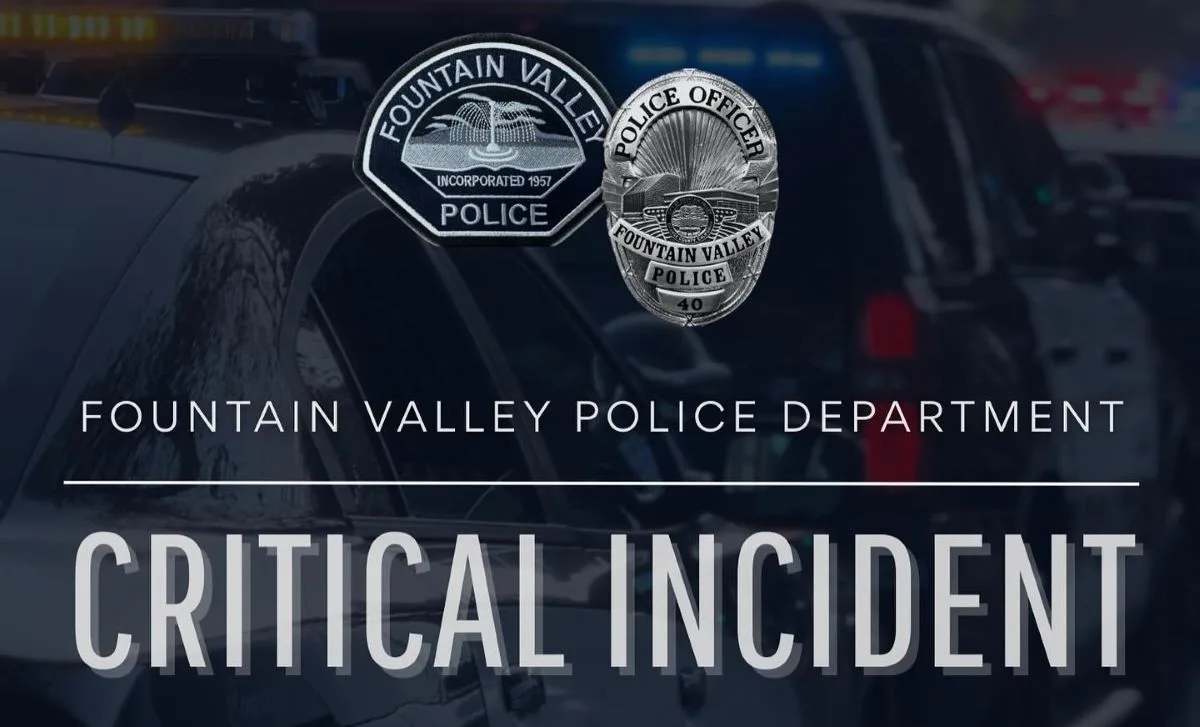The Fountain Valley Police Department (FVPD) has released a Critical Incident Community Briefing video detailing the events surrounding an officer-involved shooting that occurred on Friday, January 24, 2025.
The incident involved Osean McClintock, who was fatally shot during an altercation with a Fountain Valley Police Officer during a call for service.
Fountain Police Department officers responded to the area on Jan. 24 for reports of someone trying to get into an occupied car near Kazuo Masuda Middle School.
When they found the suspect, McClintock, a 26-year-old, he fled on foot and the officers pursued him. McClintock then ran first to a nearby gas station then to a bank and a parking lot.
The officers caught up with McClintock at the intersection of San Mateo Street and El Corazon Avenue. He then began to struggle with a female officer while she was still in her patrol car.
Police body cam video footage shows McClintock as he takes the officer’s gun away from her.
Then theyy both ended up outside the police vehicle.
The female officer pleaded with McClintock “Please don’t shoot me!” as he was steps away from her, as seen in the video.
The officer’s partner then arrived at the scene and he saved the female officer by shooting McClintock, who had climbed onto the police car. The suspect then died at the scene. Police officers are not trained to wound. They are trained to put down dangerous suspects and that is what this officer did.
The Critical Incident Community Briefing video includes body-worn camera footage and other relevant information to provide transparency and context regarding the incident.
The Fountain Valley Police Department remains committed to transparency and accountability in all of its operations. The release of this video is part of their ongoing efforts to keep the community informed and engaged.
Had McClintock lifed he would have faced serious felony charges for his actions. Taking a gun from a police officer and threatening them is an extremely serious offense with significant penalties under California law. Here’s a breakdown of the likely charges and potential penalties:
Likely Charges:
- Assault with a Deadly Weapon on a Peace Officer (California Penal Code § 245(c)): This charge specifically addresses assaults on police officers with a deadly weapon, which a firearm certainly is.
- Taking a Firearm from a Peace Officer (California Penal Code § 148(d)): This law makes it a felony to attempt to remove or take a firearm from a peace officer. If the firearm is successfully taken, this charge is even more serious.
- Criminal Threats (California Penal Code § 422): Threatening an officer with a firearm would likely constitute a criminal threat, especially if the threat causes the officer to fear for their safety.
- Resisting an Executive Officer with Threats or Violence (California Penal Code § 69): Using a threat of violence, such as with a stolen firearm, to resist a police officer in the performance of their duties is a felony.
Potential Penalties:
The penalties for these offenses can be severe and often carry mandatory minimum sentences and enhancements due to the involvement of a firearm and a peace officer. Here’s a general overview of potential penalties:
- Assault with a Deadly Weapon on a Peace Officer (§ 245(c)): This is a felony. The punishment can include significant state prison time, potentially ranging from several years up to a longer term depending on the circumstances and any enhancements.
- Taking a Firearm from a Peace Officer (§ 148(d)): This is also a felony. The penalties can include state prison time, and there may be enhancements depending on whether the officer was injured.
- Criminal Threats (§ 422): This can be charged as a misdemeanor or a felony (“wobbler”). Felony convictions can result in state prison time, and using a deadly weapon during the commission of this crime can add an additional year to the prison sentence.
- Resisting an Executive Officer with Threats or Violence (§ 69): This is a felony, carrying a potential state prison sentence and/or a substantial fine. If a firearm is involved in the threat, the penalties can be significantly increased.
Additional Considerations:
- Felony Charges: All of these likely charges are felonies, which carry long-term consequences, including the loss of the right to own firearms for life.
- “Strike” under California’s Three Strikes Law: Certain felony convictions, especially those involving violence or firearms, can count as a “strike” under California’s Three Strikes Law, which can lead to much harsher penalties for subsequent felony convictions.
- Federal Charges: Depending on the specifics, there could also be federal charges involved.
It is difficult to determine the exact percentage of U.S. police officers who die specifically when their gun is taken away by a criminal suspect. However, available data can provide some context:
General Statistics on Officer Fatalities and Firearms:
- Firearms are the leading cause of felonious deaths for law enforcement officers in the United States.
- In 2023, 47 officers were killed by gunfire out of a total of 136 line-of-duty deaths.
- From 2012 to 2021, 456 out of 504 officers feloniously killed were shot with a gun (approximately 90%).
Incidents Involving an Officer’s Own Firearm:
- A study analyzing law enforcement officer homicides indicated that in 10% of cases where officers were fatally shot, they were killed with their own firearm.
- In 2011, 3 officers were killed with their own weapons out of 63 officers killed with firearms.
